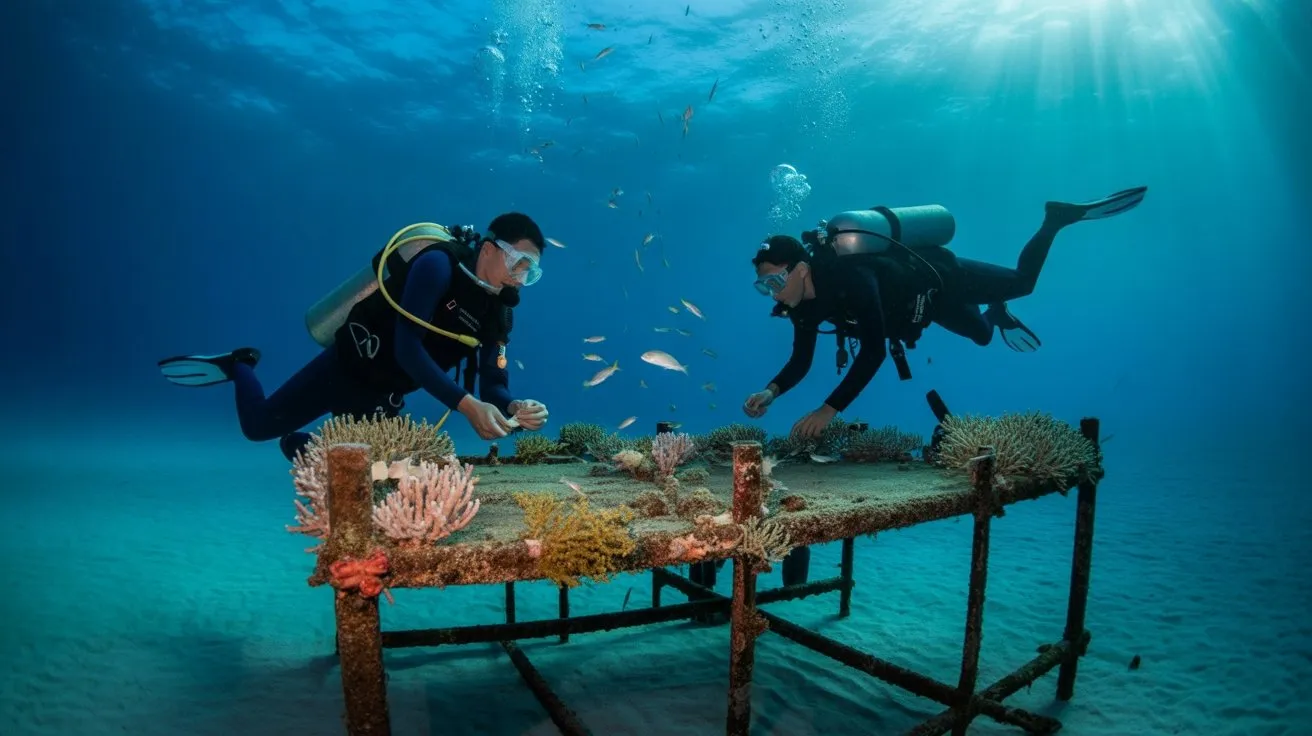You’ll encounter some of nature’s most spectacular chromatic displays when exploring coral reef ecosystems. These vibrant fish species have evolved complex pigmentation systems involving chromatophores, iridophores, and specialized cellular structures that produce their stunning visual appearances. From the psychedelic patterns of Synchiropus splendidus to the electric blues of Paracanthurus hepatus, each species demonstrates unique evolutionary adaptations. Understanding the biological mechanisms behind these remarkable colorations reveals fascinating insights about reef ecology, predator-prey relationships, and survival strategies that’ll transform how you perceive underwater biodiversity.
Mandarin Fish: Living Psychedelic Art in Motion
Synchiropus splendidus exhibits one of nature’s most extraordinary color patterns, featuring electric blue lines that course across its orange and green body like neural pathways illuminated under ultraviolet light.
You’ll find this dragonet species inhabiting coral rubble and reef crevices throughout the Western Pacific, from the Ryukyu Islands to Australia’s Great Barrier Reef.
The mandarin fish’s vivid coloration results from chromatophores containing cyanophores—rare blue pigment cells found in few vertebrates.
You won’t easily spot these nocturnal feeders during daylight hours, as they remain hidden within coral branches and rock formations.
Their specialized diet consists primarily of copepods, amphipods, and polychaete worms, which they capture using their protrusible premaxilla.
Males develop elongated dorsal fin spines and establish territories during breeding season. Additionally, their habitat is crucial for coral reef ecosystems, providing shelter and resources for many marine species.
Parrotfish: Rainbow Giants of the Reef

While mandarin fish dazzle with intricate patterns on a diminutive scale, parrotfish command attention through sheer size and spectacular coloration that rivals any tropical sunset. You’ll encounter these herbivorous giants displaying dramatic sexual dichromatism, where males exhibit brilliant blues, greens, and oranges distinct from their female counterparts. Coral reefs, which they inhabit, play a crucial role in supporting marine life by providing essential habitats and food sources.
| Species | Terminal Phase Colors | Size Range | Distribution |
|---|---|---|---|
| *Scarus guacamaia* | Turquoise-green body, orange margins | 90-120 cm | Caribbean reefs |
| *Chlorurus microrhinos* | Electric blue-green, pink accents | 60-70 cm | Indo-Pacific |
| *Scarus vetula* | Emerald green, coral-pink fins | 30-60 cm | Western Atlantic |
| *Hipposcarus longiceps* | Cobalt blue, yellow-orange bands | 50-60 cm | Red Sea, Indo-Pacific |
You’ll observe their beak-like mouths scraping algae from coral surfaces, producing characteristic crunching sounds while contributing greatly to reef sediment formation through their digestive processes.
Angelfish: Ethereal Beauty in Brilliant Patterns
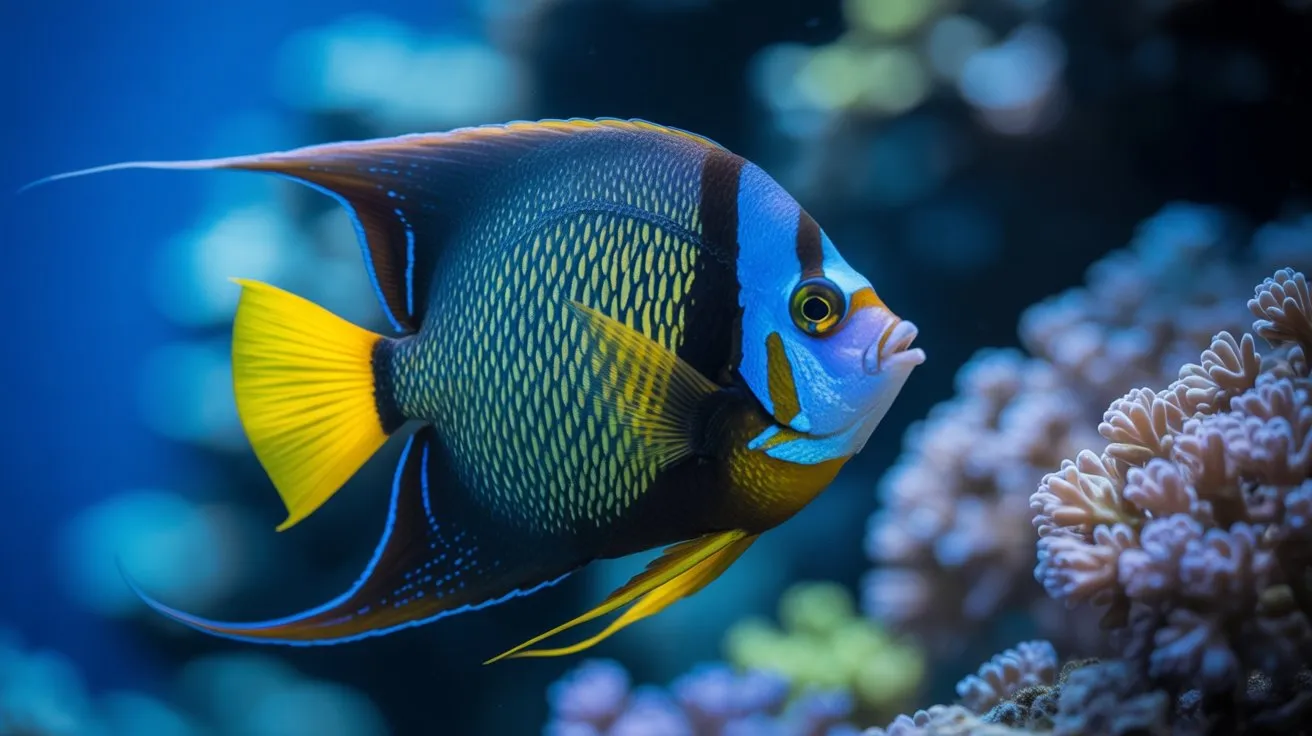
Graceful angelfish glide through coral formations with disk-shaped bodies that showcase some of the reef’s most intricate geometric patterns and vibrant color combinations.
You’ll encounter the Emperor Angelfish (*Pomacanthus imperator*) displaying electric blue stripes against golden-yellow backgrounds, while Queen Angelfish (*Holacanthus ciliaris*) exhibit brilliant blue bodies with yellow-trimmed fins and distinctive crown-like head markings.
French Angelfish (*Pomacanthus paru*) present striking black bodies accented with bright yellow scale edges, creating mesh-like patterns.
You’ll notice juvenile angelfish often display completely different coloration than adults—a phenomenon called ontogenetic color change. Gray Angelfish (*Pomacanthus arcuatus*) demonstrate this transformation from yellow juveniles with blue stripes to silvery-gray adults.
These compressed, laterally-flattened fish navigate tight coral crevices using precise fin movements, their brilliant patterns serving both territorial displays and camouflage functions. The health of angelfish populations is closely linked to the overall health of coral reefs, emphasizing the need for conservation efforts to protect their habitat.
Clownfish: Orange and White Striped Celebrities
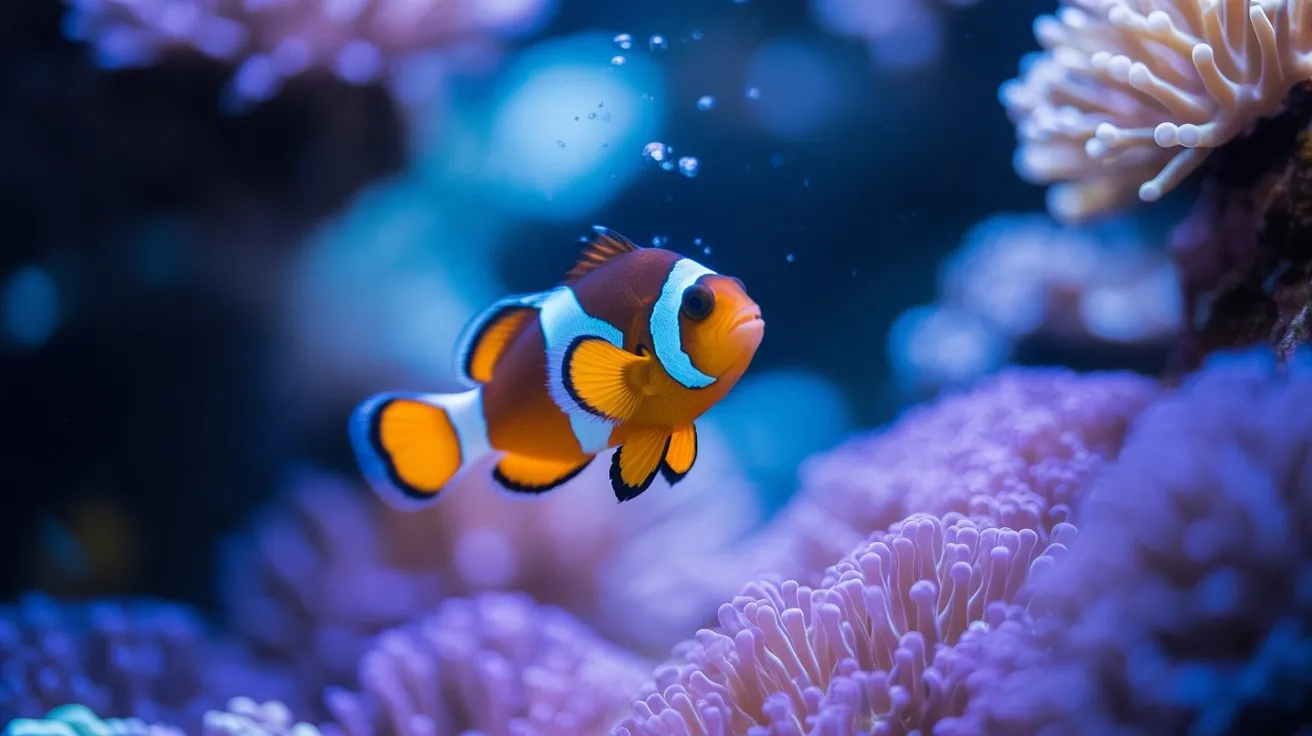
You’ll observe sequential hermaphroditism in clownfish populations, where dominant individuals change from male to female when necessary.
*Amphiprion ocellaris* and *A. percula* represent the most common species, though fourteen distinct species exist.
Their aggressive territorial behavior intensifies during breeding season when males prepare circular nesting sites on hard substrates adjacent to host anemones, fiercely guarding developing eggs.
Blue Tangs: Electric Sapphires of Tropical Waters
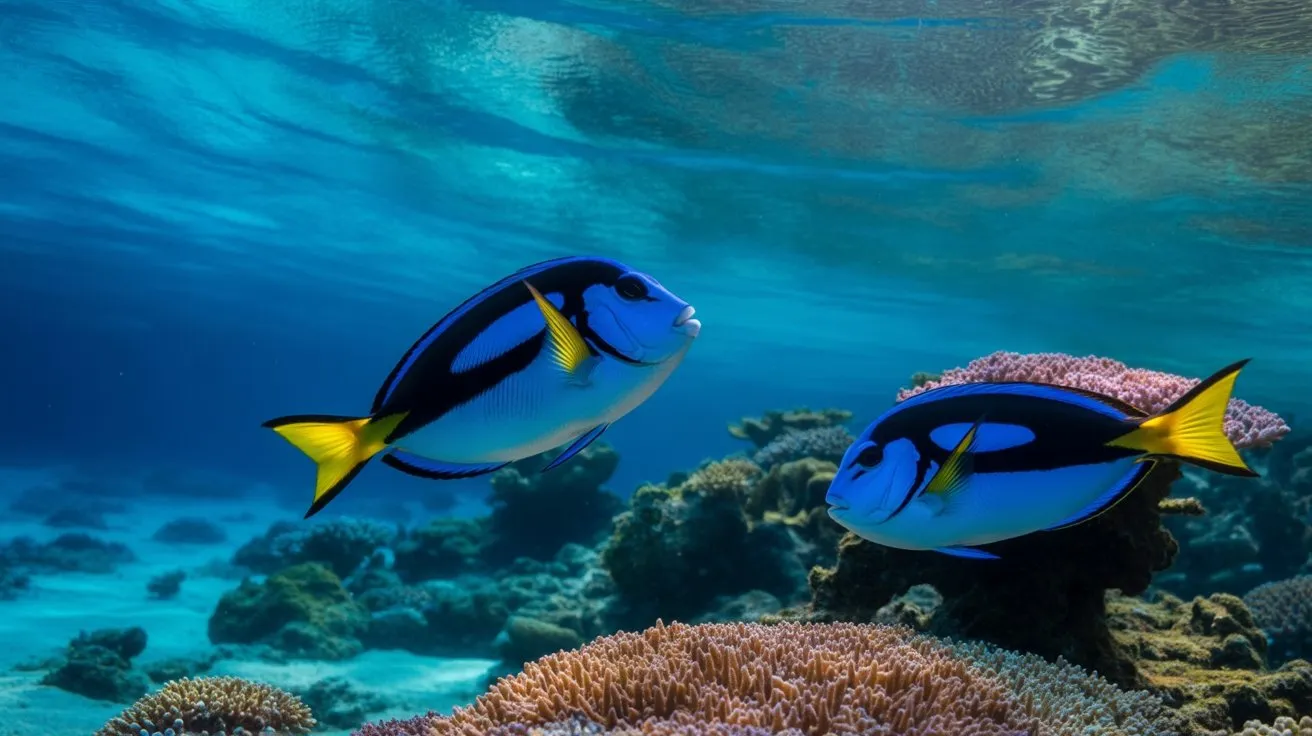
These herbivorous surgeonfish exhibit three remarkable behavioral adaptations:
- Schooling behavior – They form large aggregations for enhanced foraging efficiency and predator avoidance.
- Algae grazing – Their specialized pharyngeal teeth process filamentous algae and detritus from coral substrates.
- Territorial defense – Males establish cleaning stations where they remove parasites from other reef species.
You’ll observe their razor-sharp scalpel-like spines near the caudal peduncle, which they deploy when threatened.
Their streamlined morphology enables rapid acceleration through complex coral formations. Additionally, their grazing helps maintain the balance of the reef ecosystem by preventing excessive algae growth, which can threaten coral health and predation dynamics.
Butterflyfish: Delicate Wings Beneath the Waves
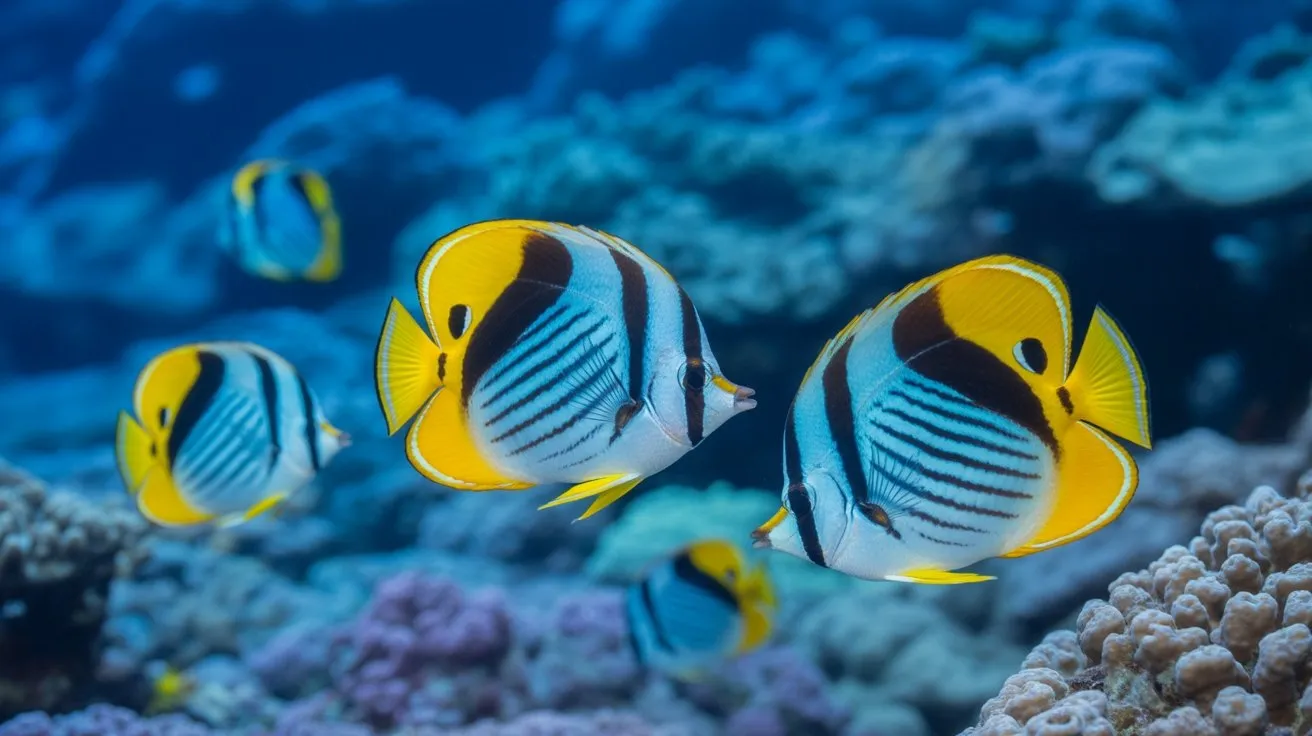
Butterflyfish display extraordinary morphological specializations that enable precise foraging in the intricate crevices of coral reef ecosystems.
You’ll observe their laterally compressed bodies and elongated snouts facilitating access to narrow coral polyp chambers. Chaetodon auriga exhibits distinctive threadfin extensions, while C. lunula demonstrates remarkable territorial behaviors around Acropora formations.
You can identify C. trifascialis by its distinctive black eye-bands and yellow dorsal coloration, perfectly adapted for Pocillopora coral feeding. Their protrusible jaws extract invertebrates with surgical precision.
C. vagabundus displays aggressive intraspecific competition for ideal feeding territories.
These specialized planktivores maintain strict home ranges, typically 10-50 square meters.
You’ll notice their paired swimming patterns during reproductive seasons, when monogamous pairs establish temporary spawning aggregations near reef edges at dawn. Coral reefs are essential habitats that support these vibrant species and countless others.
Wrasses: Masters of Color-Changing Camouflage
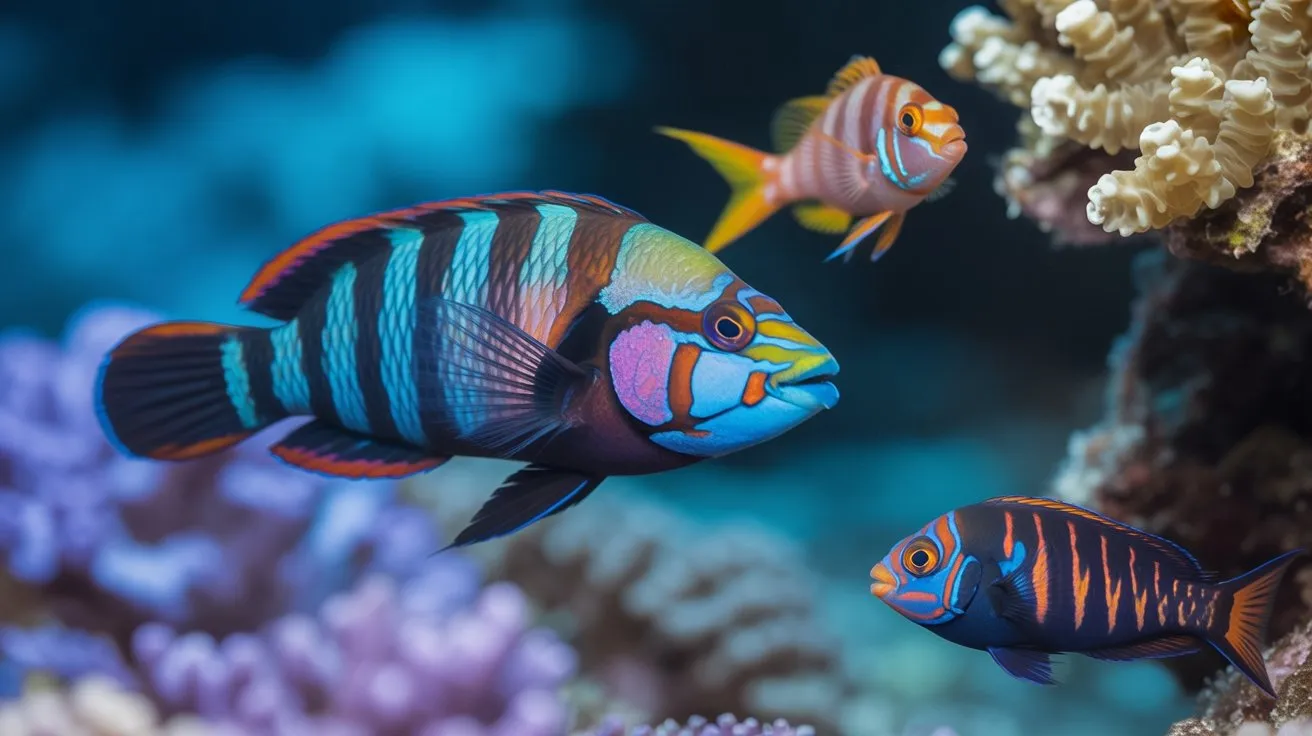
While butterflyfish rely on morphological adaptations for feeding precision, wrasses (family Labridae) demonstrate unparalleled chromatophore control that enables instantaneous camouflage responses to environmental stimuli.
You’ll observe these remarkable fish executing rapid color transformations through specialized pigment-containing cells called iridophores and chromatophores.
Wrasse camouflage mechanisms include:
- Behavioral mimicry – Cleaner wrasses (Labroides dimidiatus) alter coloration to match substrate textures when avoiding predators.
- Sexual dimorphism displays – Terminal phase males exhibit brilliant blues and greens during territorial disputes.
- Stress-induced melanophore activation – Rapid darkening occurs within milliseconds when threatened.
You’re witnessing highly evolved neurological pathways controlling pigment cell distribution.
Species like the sixline wrasse (Pseudocheilinus hexataenia) demonstrate particularly sophisticated chromatic responses, adjusting spectral reflectance to optimize concealment against specific coral formations and rocky substrates.
Triggerfish: Bold Patterns and Vibrant Personalities
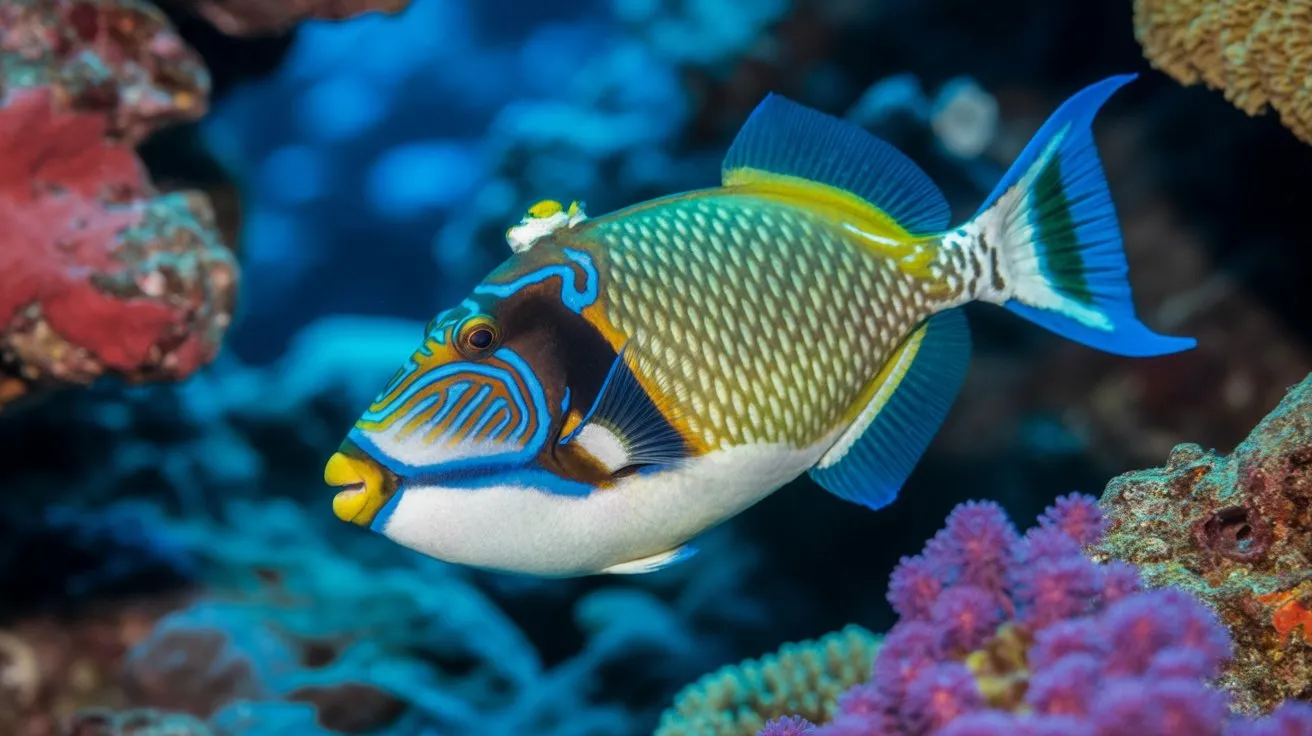
Unlike wrasses’ subtle camouflage tactics, triggerfish (family Balistidae) command attention through their aggressive territorial displays and striking geometric patterns.
You’ll encounter species like the Picasso triggerfish (*Rhinecanthus aculeatus*) with its distinctive yellow, blue, and black angular markings resembling abstract art. The clown triggerfish (*Balistoides conspicillum*) displays large white polka dots against a dark body with bright yellow fins.
These fish possess laterally compressed bodies and specialized dorsal spines they’ll erect when threatened.
You’ll observe their territorial nature during nesting seasons when males vigorously defend sandy crater nests. Triggerfish use powerful jaws to crush sea urchins, crabs, and mollusks.
Their bold coloration serves dual purposes: species recognition and intimidation displays that warn potential competitors of their formidable defensive capabilities. Additionally, the health of coral reefs, which provide habitats for these vibrant fish, is jeopardized by climate change, underscoring the importance of conservation efforts.
Groupers: Gentle Giants in Stunning Hues
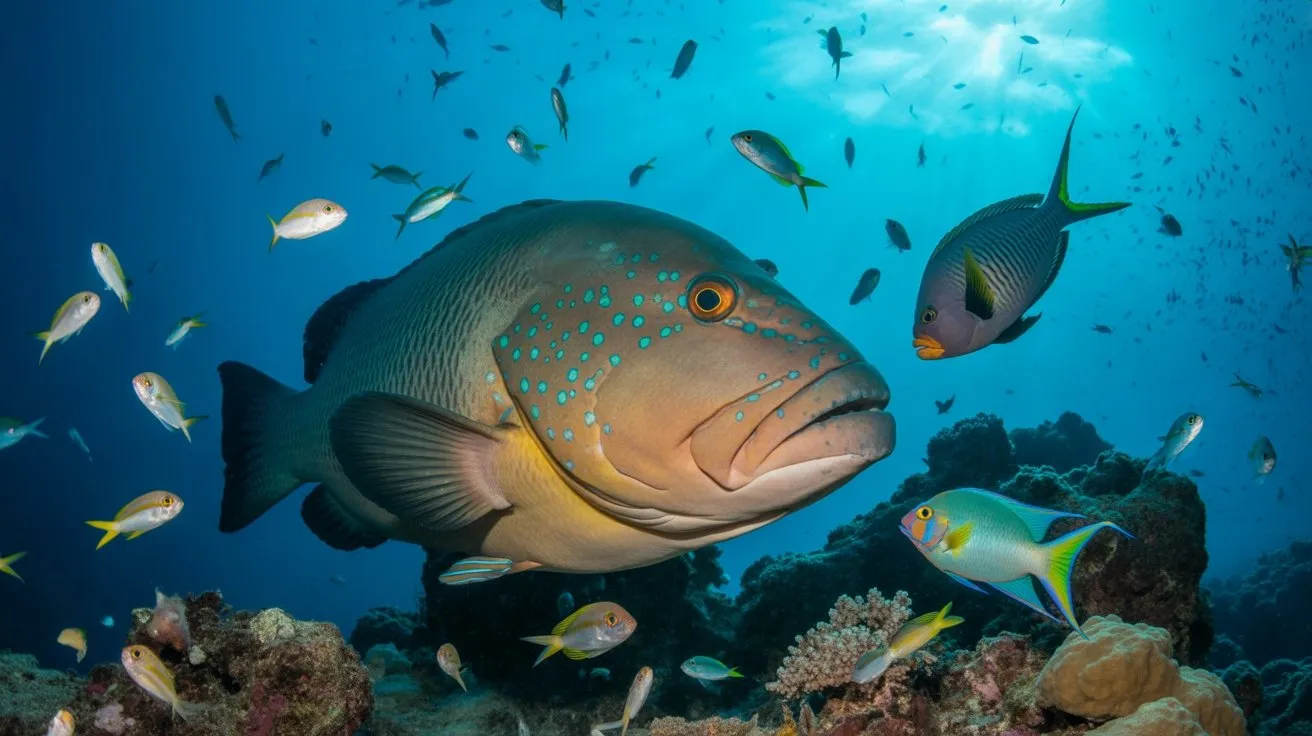
Moving from the aggressive displays of triggerfish, you’ll discover groupers (family Serranidae) present a markedly different temperament despite their imposing size.
These benthic predators exhibit remarkable coloration patterns that change dramatically with behavioral states, habitat requirements, and reproductive cycles.
You’ll observe three primary color-changing mechanisms in reef groupers:
- Chromatophore activation – Rapid pigment cell expansion creates instant pattern shifts for camouflage or communication
- Ontogenetic color changes – Juvenile coloration differs considerably from adult phases, particularly in Epinephelus species
- Sexual dichromatism – Terminal-phase males display enhanced pigmentation during spawning aggregations
Nassau groupers (Epinephelus striatus) demonstrate exceptional color versatility, shifting from barred patterns to solid dark phases.
Their docile nature contrasts sharply with their predatory capabilities, making them fascinating subjects for underwater observation.
Damselfish: Small but Mighty Bursts of Color
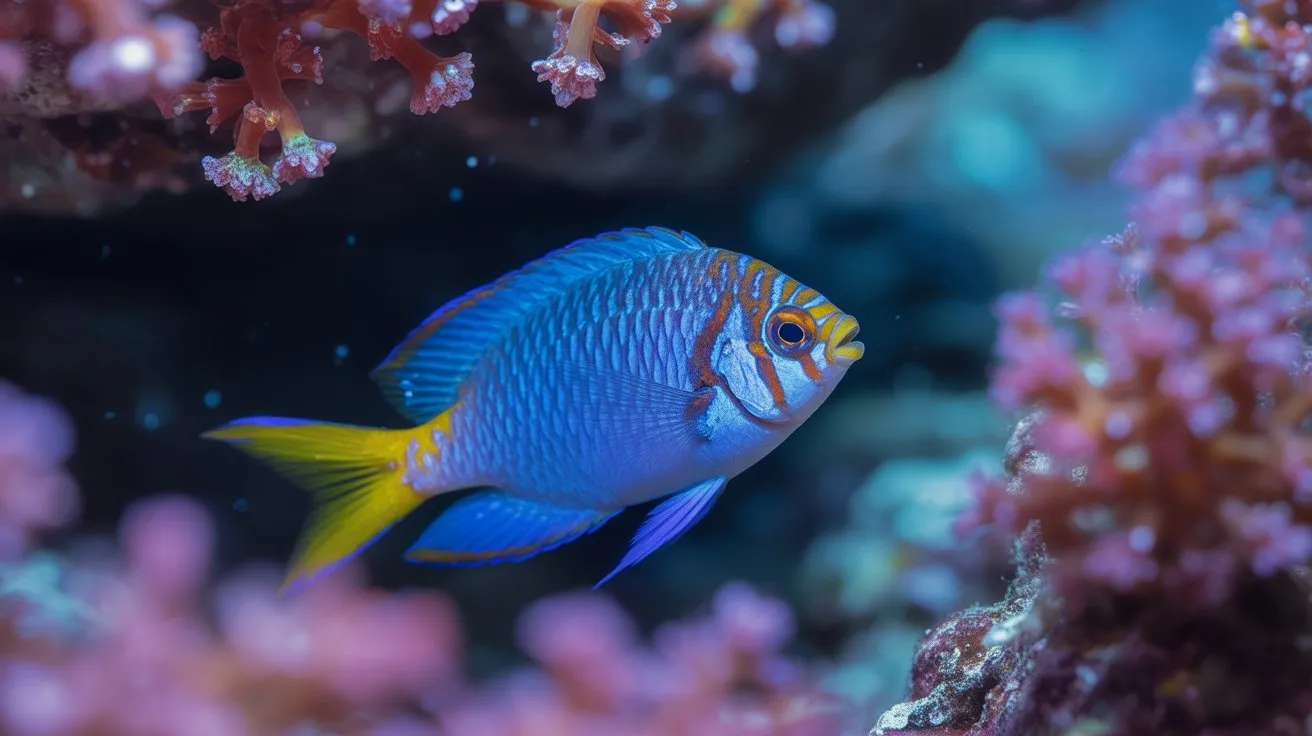
Shifting focus from the reef’s larger inhabitants, damselfish (family Pomacentridae) demonstrate that size doesn’t dictate visual impact on coral ecosystems.
You’ll encounter these territorial defenders displaying vibrant blues, yellows, and purples across their 2-6 inch frames. The electric blue tang (Paracanthurus hepatus) showcases cobalt coloration with black patterns, while yellowtail damselfish (Microspathodon chrysurus) exhibit brilliant yellow posterior regions contrasting with dark anterior bodies.
Blue-green chromis (Chromis viridis) form shimmering aggregations above staghorn corals, their iridescent scales reflecting ambient light. These planktivores aggressively defend feeding territories despite their diminutive size. Their presence highlights the importance of marine biodiversity, as these small fish play crucial roles in maintaining the health of coral reef ecosystems.
You’ll observe their rapid darting movements as they chase away much larger intruders, proving that behavioral intensity often compensates for physical limitations in reef environments.
Conclusion
You’ve witnessed coral reef fish that function like living prisms, each species demonstrating distinct chromatic adaptations for survival. When you observe these organisms in their natural habitat, you’ll notice their pigmentation serves critical functions: territorial signaling, predator evasion, and mate selection. Their chromatophores actively produce these spectacular displays through specialized cellular mechanisms. As you explore reef ecosystems, you’re experiencing biodiversity that’s evolved over millennia to create nature’s most vibrant underwater gallery.





